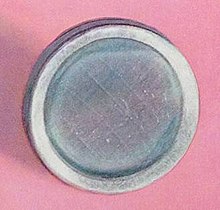
Back Polonium Afrikaans ፖሎኒየም Amharic Polonio AN पोलोनियम ANP بولونيوم Arabic پولونيوم ARY بولونيوم ARZ Poloniu AST Polonium Azerbaijani Полоний Bashkir
 | ||||||||||||||||||||||||||||||
| Polonium | ||||||||||||||||||||||||||||||
|---|---|---|---|---|---|---|---|---|---|---|---|---|---|---|---|---|---|---|---|---|---|---|---|---|---|---|---|---|---|---|
| Pronunciation | /pəˈloʊniəm/ | |||||||||||||||||||||||||||||
| Allotropes | α, β | |||||||||||||||||||||||||||||
| Appearance | silvery | |||||||||||||||||||||||||||||
| Mass number | [209] | |||||||||||||||||||||||||||||
| Polonium in the periodic table | ||||||||||||||||||||||||||||||
| ||||||||||||||||||||||||||||||
| Atomic number (Z) | 84 | |||||||||||||||||||||||||||||
| Group | group 16 (chalcogens) | |||||||||||||||||||||||||||||
| Period | period 6 | |||||||||||||||||||||||||||||
| Block | p-block | |||||||||||||||||||||||||||||
| Electron configuration | [Xe] 4f14 5d10 6s2 6p4 | |||||||||||||||||||||||||||||
| Electrons per shell | 2, 8, 18, 32, 18, 6 | |||||||||||||||||||||||||||||
| Physical properties | ||||||||||||||||||||||||||||||
| Phase at STP | solid | |||||||||||||||||||||||||||||
| Melting point | 527 K (254 °C, 489 °F) | |||||||||||||||||||||||||||||
| Boiling point | 1235 K (962 °C, 1764 °F) | |||||||||||||||||||||||||||||
| Density (near r.t.) | α-Po: 9.196 g/cm3 β-Po: 9.398 g/cm3 | |||||||||||||||||||||||||||||
| Heat of fusion | ca. 13 kJ/mol | |||||||||||||||||||||||||||||
| Heat of vaporization | 102.91 kJ/mol | |||||||||||||||||||||||||||||
| Molar heat capacity | 26.4 J/(mol·K) | |||||||||||||||||||||||||||||
Vapor pressure
| ||||||||||||||||||||||||||||||
| Atomic properties | ||||||||||||||||||||||||||||||
| Oxidation states | common: −2, +2, +4 +5[1] +6,[2] | |||||||||||||||||||||||||||||
| Electronegativity | Pauling scale: 2.0 | |||||||||||||||||||||||||||||
| Ionization energies |
| |||||||||||||||||||||||||||||
| Atomic radius | empirical: 168 pm | |||||||||||||||||||||||||||||
| Covalent radius | 140±4 pm | |||||||||||||||||||||||||||||
| Van der Waals radius | 197 pm | |||||||||||||||||||||||||||||
| Other properties | ||||||||||||||||||||||||||||||
| Natural occurrence | from decay | |||||||||||||||||||||||||||||
| Crystal structure | cubic α-Po | |||||||||||||||||||||||||||||
| Crystal structure | rhombohedral β-Po | |||||||||||||||||||||||||||||
| Thermal expansion | 23.5 µm/(m⋅K) (at 25 °C) | |||||||||||||||||||||||||||||
| Thermal conductivity | 20 W/(m⋅K) (?) | |||||||||||||||||||||||||||||
| Electrical resistivity | α-Po: 0.40 µΩ⋅m (at 0 °C) | |||||||||||||||||||||||||||||
| Magnetic ordering | nonmagnetic | |||||||||||||||||||||||||||||
| CAS Number | 7440-08-6 | |||||||||||||||||||||||||||||
| History | ||||||||||||||||||||||||||||||
| Naming | after Polonia, Latin for Poland, homeland of Marie Curie | |||||||||||||||||||||||||||||
| Discovery | Pierre and Marie Curie (1898) | |||||||||||||||||||||||||||||
| First isolation | Willy Marckwald (1902) | |||||||||||||||||||||||||||||
| Isotopes of polonium | ||||||||||||||||||||||||||||||
| ||||||||||||||||||||||||||||||
Polonium is a chemical element; it has symbol Po and atomic number 84. A rare and highly radioactive metal (although sometimes classified as a metalloid) with no stable isotopes, polonium is a chalcogen and chemically similar to selenium and tellurium, though its metallic character resembles that of its horizontal neighbors in the periodic table: thallium, lead, and bismuth. Due to the short half-life of all its isotopes, its natural occurrence is limited to tiny traces of the fleeting polonium-210 (with a half-life of 138 days) in uranium ores, as it is the penultimate daughter of natural uranium-238. Though longer-lived isotopes exist, such as the 124 years half-life of polonium-209, they are much more difficult to produce. Today, polonium is usually produced in milligram quantities by the neutron irradiation of bismuth. Due to its intense radioactivity, which results in the radiolysis of chemical bonds and radioactive self-heating, its chemistry has mostly been investigated on the trace scale only.
Polonium was discovered on July 18, 1898 by Marie Skłodowska-Curie and Pierre Curie, when it was extracted from the uranium ore pitchblende[4] and identified solely by its strong radioactivity: it was the first element to be discovered in this way.[5] Polonium was named after Marie Skłodowska-Curie's homeland of Poland, which at the time was partitioned between three countries. Polonium has few applications, and those are related to its radioactivity: heaters in space probes, antistatic devices, sources of neutrons and alpha particles, and poison (e.g., poisoning of Alexander Litvinenko). It is extremely dangerous to humans.
- ^ Thayer, John S. (2010). "Relativistic Effects and the Chemistry of the Heavier Main Group Elements". Relativistic Methods for Chemists. Challenges and Advances in Computational Chemistry and Physics. 10: 78. doi:10.1007/978-1-4020-9975-5_2. ISBN 978-1-4020-9974-8.
- ^ Greenwood, Norman N.; Earnshaw, Alan (1997). Chemistry of the Elements (2nd ed.). Butterworth-Heinemann. p. 28. ISBN 978-0-08-037941-8.
- ^ Kondev, F. G.; Wang, M.; Huang, W. J.; Naimi, S.; Audi, G. (2021). "The NUBASE2020 evaluation of nuclear properties" (PDF). Chinese Physics C. 45 (3): 030001. doi:10.1088/1674-1137/abddae.
- ^ "Polonium (Po) | AMERICAN ELEMENTS ®". American Elements: The Materials Science Company. Retrieved 17 April 2024.
- ^ Radvanyi, Pierre; Villain, Jacques (1 November 2017). "The discovery of radioactivity". Comptes Rendus. Physique. 18 (9–10): 544–550. Bibcode:2017CRPhy..18..544R. doi:10.1016/j.crhy.2017.10.008.


